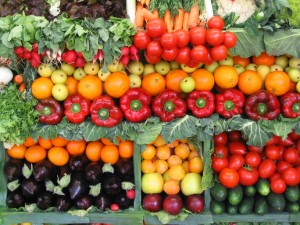Hurting from Alberta’s Recession? 12 Tips to Save Money on Groceries
 Oil prices below $30 per barrel, much higher prices at the grocery store, and paying a lot more for everything imported as the loonie plunges are leaving many residents of Spruce Grove, Stony Plain and Parkland County bewildered and wondering how to cope.
Oil prices below $30 per barrel, much higher prices at the grocery store, and paying a lot more for everything imported as the loonie plunges are leaving many residents of Spruce Grove, Stony Plain and Parkland County bewildered and wondering how to cope.
Financial advisors typically suggest that we prepare and follow a budget, keep track of expenses, spend less than we earn, and so on. What are some easy to follow tips that won’t make you feel that you have to lower your standard of living?
Today’s focus is on cutting food costs.
1. Prepare your meals at home from scratch to stretch your food dollars the farthest. The vast quantities of pre-prepared and processed food items at the grocery store may be convenient but they will cost you more. And if you think you don’t know how to cook – it’s never too late to learn!
2. Deliberately cook more than you’ll consume for dinner. Then package and freeze the rest for another meal, or plan to pack it for your lunch the next day. Bringing your lunch from home instead of paying restaurant prices will save you big.
3. Learn what groceries cost. This means educating yourself about how much the price of the same item can differ from one store to another, or from one week or season to the next. Study the prices in the stores and better yet, read the flyers. Some people shop only in the one store that they feel has the best deals or the best selection. Other people visit several stores in order to save the most money on individual items. Find a strategy that works for you.
4. Plan ahead. Make a list before you go shopping based on: a) what you need for meals for the next week, b) what your family will use up before the next shopping trip, and especially c) what is on sale as listed in the store’s flyer. Stick to the list, and avoid impulse buys. Don’t buy more than you can comfortably store and use. Shop just once a week, or less. You’ve probably also heard the advice not to shop on an empty stomach!
5. Buying in bulk is cheaper than buying small packages and makes sense for food items that keep for a long time and are used often in your home. Do a lot of baking? Buy the largest bags of sugar and flour you can find (on sale, please!) and store them appropriately. Looking to sample something for the first time? A small package may be more economical in the long run.
6. Be aware of the tricks stores use to get you to buy more or to buy higher priced items in a particular category. A store in Spruce Grove routinely offers cottage cheese for a special price – but only if you buy three large containers. Good deal if your family consumes a lot of cottage cheese; not so great if half of it spoils before you use it.
Note how items are displayed on store shelves. Higher priced and name brand items tend to occupy the real estate within easy reach and at eye level. Take the time to compare prices between brands and between different sizes of the same product.
7. Ask yourself if you must have the name brand you’ve seen advertised on TV (for a premium price; they have to pay for that advertising somehow!), or if the generic or store brand item could be just as good. Generic (“no name”) and store brand items are usually manufactured by the same companies that produce the name brand stuff but without the fancy packaging. No name butter? Half the price of the name brand stuff and tastes just the same!
8. Along with ditching many name brand products for cheaper but just as good no name or store brand items, consider what you regularly put on your plate. Deliberately seek out cheaper options, such as cheaper cuts of meat, “manager’s specials”, or even less meat. Look also for meat and produce that has been discounted. A local grocery store slaps “30% off” stickers early in the morning on meat that is close to its best before date. Substitute cheaper and often healthier and just as flavorful fruits and vegetables, especially those grown closer to home, for more exotic and imported produce.
 9. In the summer months, patronize your local farmers’ markets for the freshest and healthiest produce. Often cheaper too than what you’ll find at the store. Should you grow your own garden? That depends. In truth, you may not save money since seeds, bedding plants, fertilizer, water and gardening tools all cost money. What’s more, the garden tends to yield its bounty all at once, providing far more than most people can use at one time. However, if your family is large and you are prepared to can or freeze the harvest for later use, a garden can be a good investment in money and health.
9. In the summer months, patronize your local farmers’ markets for the freshest and healthiest produce. Often cheaper too than what you’ll find at the store. Should you grow your own garden? That depends. In truth, you may not save money since seeds, bedding plants, fertilizer, water and gardening tools all cost money. What’s more, the garden tends to yield its bounty all at once, providing far more than most people can use at one time. However, if your family is large and you are prepared to can or freeze the harvest for later use, a garden can be a good investment in money and health.
10. Consider eliminating the purchase of some things altogether, such as bottled water and soft drinks, or packaged cookies. This will not only help your wallet but your waistline too!
11. Some people advise a cash only strategy for grocery shopping. But many no-fee credit cards give valuable rewards that can lower your grocery bills or help your budget in other ways. If you shop at the Real Canadian Super Store, your President’s Choice Financial MasterCard will give you points every time you use it. Those points, which add up quickly, can then be redeemed for “free” food. Other stores have similar programs; for example, Sobey’s and Safeway offer AirMiles. These programs cost nothing to join and they do pay off!
12. Paper coupons used to be the way to shave money off a grocery bill. They still exist but the modern way uses a variety of websites and apps that give money off or provide rebates. An upcoming blog article will showcase these apps. Stay tuned!
Do you have other tips to save money on groceries? Let me know and I’ll post readers’ contributions in a future blog article or on social media. Call or text me at 780-910-9669, email me at barry@barryt.ca, or contact me here.
Tags: Money-saving ideas


